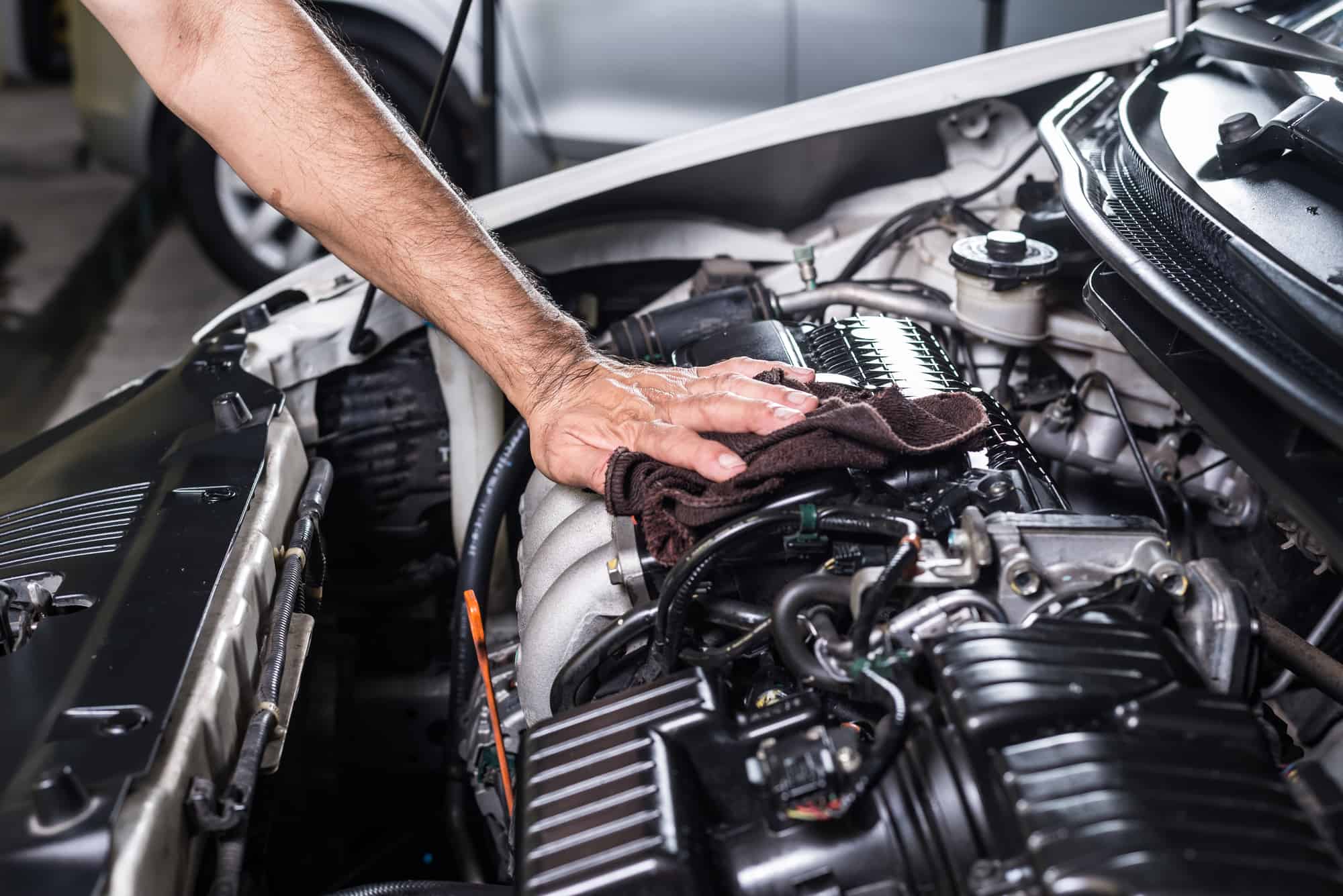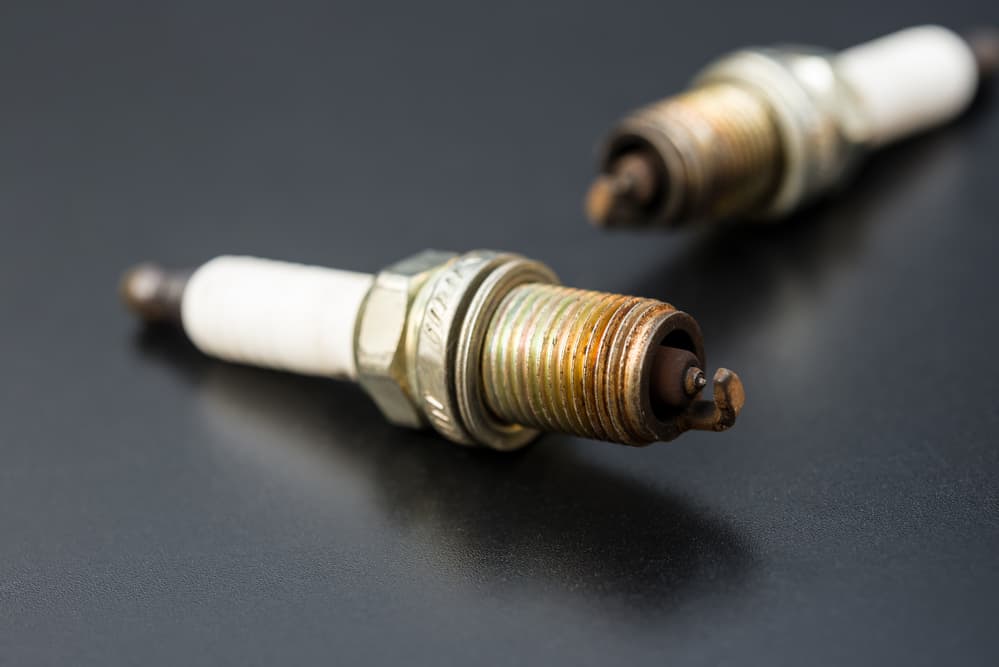Spark plugs are without doubt, the most important part of the engine ignition system. One or more bad spark plugs is going to mess up how the engine runs, and will cause problems such as engine misfires and poor fuel economy.
The symptoms of bad spark plugs include poor engine performance, rough engine idle, engine knocking noises, lack of engine power, increased exhaust emissions and a strong smell of fuel from the tailpipe.
It’s therefore important to check and replace spark plugs regularly. They provide the ignition energy (spark) that in turn starts the combustion process. So to put it simply, without spark no combustion is possible.
As an Amazon Associate we earn from qualifying purchases.
What Are The Symptoms Of Bad Spark Plugs?
The effects of bad spark plugs can be varied, and can be the same as those caused by the failure of other engine components. It’s important that if you’ve got any of the following symptoms that you rule out the spark plugs first by taking them out and examining them.
Spark plugs are usually cheaper to replace than other engine parts, so even if they look ok, it might not be a bad idea to change them anyway.
1. Poor Fuel Economy
A very common symptom of bad spark plugs is a noticeable drop in fuel economy. Contrary to other components that influence gas mileage, the effect of bad spark plugs is far more noticeable. Some studies have shown up to a 30% increase in fuel consumption due to bad spark plugs. That’s a huge increase, only comparable to bad fuel injectors.
2. Engine Misfires
Engine misfires due to bad spark plugs represent a big issue that should be addressed as soon as possible. Usually an engine misfire will be accompanied by a check engine light, so you should get it checked out as soon as possible.
The incomplete fuel burning in the combustion chamber can easily lead to a severe misfire condition and all its associated outcomes:
- Intermittent stumbling sounds on the engine.
- Possible engine knocking that could lead to drastic mechanical problems.
- Performance issues and power loss.
- Carbon deposits build-up on spark plugs (if not already present).
- Other ignition problems.
3. Engine Back Firing
This symptom is normally associated with an improper air to fuel ratio, specifically a lean air-fuel mixture. However, unburned fuel particles could also explode in the exhaust system due to its high temperature.
This can vary from vehicle to vehicle, but it is still possible and should be checked out as soon as possible so as not to damage the catalytic converter. If you have an OBD code reader you may see codes such as P0420 or P0430.
4. Engine Knocking (Bad Spark Plug Sound)
You can think of engine knocking as an extreme case of engine misfires. Bad spark plugs are one of the causes of engine knocking, and this knocking is the classic bad spark plug sound that you may have heard of.
You should worry when the typical knocking sound becomes audible because the risk of mechanical damage increases exponentially under this condition. The following is just a small list of engine components that can be damaged by consistent engine knocking:

- Piston heads. The first component directly affected by engine knocking is the piston head. Depending on the intensity of the pinging, it may literally perforate the piston head.
- Piston compression rings. In a similar way to piston heads, the piston rings also withstand increased pressures due to engine knocking. A broken compression ring is not as bad as a destroyed piston head but also requires a major engine repair.
- Due to the increased pressure in the combustion chamber, the cylinder head itself could become perforated in some cases.
- As you may guess, cylinder head valves could literally “melt” due to continuous engine knocking. Increased pressure is accompanied by an increased temperature that can easily surpass the valves’ material tolerance.
- The combination of higher pressure and temperature in the combustion chamber could lead to accelerated wear of the valves, cylinder head, compression rings, and piston head which means metal debris and fuel contaminants will enter to the lubrication system causing wear on other engine components.
5. Lack Of Acceleration
The ignition system is one of the main systems responsible for acceleration. When a key component like the spark plug is faulty the acceleration performance drops significantly.
Depending on the spark plug condition, your car may experience as much as a 40% power loss.
Since few other components have such a high impact in engine performance. That’s why you should pay attention to their life expectancy. You may be running worn spark plugs without being aware of it.
6. Rough Idle
It’s very hard for the engine ECU to compensate for issues related to bad spark plugs.
The reason is simple, the ECU can only modify fuel delivery through the fuel injector’s pulse modulation or change the ignition timing, but this doesn’t help little in this case.
When the combustion efficiency is hindered by faulty spark plugs, a rough idle is almost inevitable. The severity can vary quite a lot from one engine design to another. But this symptom will always be present.
7. Engine Difficult To Start
No matter the year of your vehicle, a classic symptom attributed to bad spark plugs are hard starts. If the spark plugs are bad enough, bad spark plugs can cause a car not to start at all.
Starting the engine requires several conditions, one of them a good air-fuel mixture ignition. When spark plugs are faulty this condition is not met or is partially met, which causes the hard starts.
8. Increased Exhaust Emissions
If the engine is not running as it should with the proper air/fuel mix, then you can expect an increase in exhaust emissions.
Depending on the spark plug condition, the associated side effects can cause a failed emissions test, and this might be a problem if you live in an area with tight emissions laws.
9. Strong Gas Smell From the Tailpipe
Another common symptom of bad spark plugs is a gas smell from the exhaust fumes.
This symptom is related to the unburned fuel coming out from the combustion chamber. Fuel particles can detonate (back-fire) in the exhaust system but could also exit through the tailpipe.
This is where the strong gas smell comes from, however, be aware that bad spark plugs are only one of many possible causes for this symptom.
What Are the Causes Of Bad Spark Plugs?
What exactly makes spark plugs go bad?
Unfortunately, spark plugs can fail in lots of different ways and for lots of different reasons. If your OBD reader is giving an engine code such as P0300 or P0171, it could be caused by a bad or failing spark plug.
The only way to properly check for a faulty spark plug, is to take them out and inspect them. The following is a list of some common ways that spark plugs can go bad and cause issues.
- Oil on the spark plugs
- Excessive carbon deposits on the spark plugs.
- Different levels of normal wear (spark plugs are disposable by design).
- Fuel on the spark plugs.
- Corroded spark plugs.
- Burned spark plugs.
- Mechanical damage on the spark plug.
- Incorrect spark plug gap.
- Improper spark plug heat range.
This article focuses on identifying the typical symptoms produced by the above conditions in order to help you determine if your car is suffering from bad spark plugs issues.
How can I check to see if the spark plugs need replacing?
As you can see from the above symptoms, one or more bad spark plugs can cause a wide range of symptoms.
If you suspect a bad spark plug is to blame then you should check it out as soon as possible so as not to cause damage to your engine or damage to the catalytic converter.
1. Check To See if There are any engine error codes
Faulty spark plugs will usually cause the ECU to log one or more error codes if the symptoms are bad enough. The codes by themselves won’t usually point directly to a faulty spark plug, but will indicate that something is wrong with the ignition, fuel delivery or exhaust systems. Common error codes include P0300, P0420 and P0430.
2. Remove the Spark Plugs For A Closer Inspection
If a spark plug is the cause of your problems, then it will usually be obvious when you remove them for a closer inspection. Worn and damaged spark plugs are easy to spot.
3. Replace All Of The Spark Plugs Or Bring It To A Mechanic
If you find one or more worn spark plugs, then it’s a good idea to replace all of them in one go. Spark plugs aren’t that expensive, and even if they don’t look too worn or dirty, they still have a finite life span.
If the spark plugs look ok or were only replaced recently, then it may be a good idea to bring your car to a mechanic as there may be another cause of the symptoms your engine is creating.
What Do Bad Spark Plugs Look Like?
If a bad or failing spark plug is suspected, then the next step is to remove each plug and visually inspect them. Here are a few signs of a bad spark plug.

An example of a dirty, worn out spark plug
- Wet Or Oily Deposits – Oil on spark plugs can be caused by a leaking head gasket (engine coolant is getting into the combustion chamber). It can also be caused by leaking piston rings or an overly rich air/fuel mix. In direct injection engines, the amount of fuel fed into the engine is controlled by the ECU. Sometimes a bad or failing fuel injector will mess up the air fuel mix.
- Glazed/Glossy Electrode Tip – This indicates a spark plug that is regularly over-heated. This can be caused by an overly lean air fuel mix. It can also be caused by a spark plug that is loose in the engine.
- Dark Colour – If the spark plug is covered in dark wet or dry deposits, then this is an indication of an engine that is running rich (too much fuel). This can also be caused by a vacuum leak or low cylinder compression. In older cars, it can point to an issue with the engine timing or too large of a plug gap. In newer fuel injected cars, the timing is controlled by the ECU.
Here’s a video that explains what the different type of spark plug damage means by looking at 6 different damaged spark plugs taken from an engine.
What Are The Different Types Of Spark Plugs?
Basically, the spark plugs we are talking about here today all fall into one of four broad categories: copper, single platinum, double platinum and iridium.
Keep in mind though, even after establishing which type of spark plug that you need, there will be still be slight differences, depending on manufacturer specifications. So it’s important to double check which specific type your manufacturer recommends.
1. Copper Tipped Spark Plugs
These are the original type of spark plug and today are only really used in old (pre-90s) cars and some high performance/modified cars. Basically these plugs are made of a copper core, with a large nickel alloy electrode.
Copper offers the best conduction, hence the reason they are still used today in modified, high performance engines.
But on the flip side, they are not the hardest wearing plug. Using copper spark plugs will shorten your engine’s service interval considerably as they wear out a lot quicker than platinum or iridium plugs. Copper plugs generally only last up to 30,000 miles and can be badly worn after only 6 months.
So even though t hey are a favorite of budget-conscious car owners thanks to their low cost, they don’t last half as long as other spark plugs, and are not suited to most unmodified modern cars, especially those that operate under adverse conditions and do high mileage.
2. Single Platinum Spark Plugs
These are quite similar to their copper-tipped counterparts, except they can last as long as 100,000 miles.
Featuring a much harder wearing platinum tipped electrode, they usually operate at a higher temperature to their copper counterparts. This reduces carbon build up and keeps them looking newer and performing better longer .
A popular choice in newer vehicles, they will last much longer than copper plugs and are chosen by manufacturers’ to extend service intervals.
3. Double Platinum Spark Plugs
These are a little bit more expensive than single platinum models, but they offer a higher performance and a longer life. As the name suggests, they feature platinum discs on the centre electrode and on the outer electrode.
Originally designed to take advantage of waste-spark DIS systems, this type of plug features two platinum discs, one on the centre electrode and one on the outer, side electrode.
It’s important to note that double platinum spark plugs are not simply twice as efficient as single platinum plugs. They are actually used in specific engines with a particular type of coil and firing process. Because of this, you should never downgrade to copper or single platinum plugs if your car has double platinum plugs installed from the factory.
4. Iridium spark plugs
These are the most durable and long lasting plugs on the market, typically lasting 25-30% longer than platinum plugs.
Just like platinum plugs, the tip of the centre electrode is modified, this time with an Iridium alloy tip. To keep costs down and to improve conductivity, this tip is usually a tiny 0.4-0.6 mm in diameter.
Because the iridium alloy is hard wearing and not as good a conductor as platinum, it will last longer and generally run cooler.
How much does it cost to Replace bad spark plugs?
Replacing spark plugs is a fairly straight forward job, and should be done at regular intervals before the spark plugs go bad.
The cost associated with replacing the spark plugs can vary depending on the type of spark plug fitted to your car, the number of plugs fitted and whether you intend to pay for the labor, or if you are going to do it yourself.
There are four main types of spark plug to choose from, and you must check with your vehicle manufacturer before you choose which spark plugs you’re going to buy.
- Copper spark plugs are the cheapest type of spark plug, but you won’t find them in many modern cars. If your car is a bit older, or is a classic, then you may be able to fit copper spark plugs. Expect to pay between $10 and $15 for a set of 4 new copper plugs. Depending on the labor involved, you should be able to get them fitted for around $80 to $100. Here’s an example of NGK copper plugs.
- Single Platinum spark plugs are still fairly common in modern petrol engines. They’re not really any more expensive to buy or to fit than copper plugs, so you should still be able to but them for around $15 and get them fitted for around $100 or less. Here’s an example of NGK platinum plugs.
- Double Platinum spark plugs are much more common today than before and have dropped a lot in price recently. You can still expect to pay double the cost of single platinum or copper plugs at around $10 each, or around $40 for a set. Fitting them isn’t any more difficult than other spark plugs so you should still get the job done for $140 to $150 all in.
- Iridium spark plugs can actually be cheaper than the platinum plugs, due to their increased popularity. You can pick up a set of 4 iridium plugs for around $25 to $30, and if you leave your car in to a mechanic you can expect to get the job done for around $120 to $140.
FAQs – Bad Spark Plugs
1.What causes spark plugs to go bad quickly?
If you have just recently changed your spark plugs and one or more have gone bad again, then there’s obviously something else wrong with the engine. Bad spark plugs are usually caused by excessive oil or carbon build-up. Carbon build-up is commonly caused by poor combustion that can be caused by a range of things such as bad engine sensors, damage to the piston rings or valves or even a bad timing chain/belt or tensioner. Oily spark plugs are often caused by a faulty piston ring, a leaking head gasket, worn valve guides or a faulty spark plug o ring.
2. How to start a car with bad spark plugs?
If you suspect the reason that your car won’t start is because of bad spark plugs then your options are limited. A typical 4 cylinder engine won’t run at all if more than one of the plugs has gone bad. The best option is to replace all of the plugs with new ones to fix the problem. If you haven’t got new plugs, then you might get away with cleaning the old plugs just enough to get the engine going. Assuming the spark plug is just dirty or corroded (no oil present), then cleaning might help. Use a combination of sand paper, a wire brush and a solvent such as brake cleaner, to remove as much corrosion and grit from the spark plug threads and around the electrode. Don’t overdo it when rubbing the electrode tip as you don’t want to break it or change the factory preset gap. Make sure the spark plugs are dry and free of loose dirt before refitting them.
3. How to tell if a spark plug is misfiring?
With most modern engines, if it starts to misfire, the engine management light will come on and an error code will be logged by the ECU. The quickest way to figure out which cylinder(s) are misfiring is to hook up a code reader and check for stored codes. Common codes associated with a misfiring engine include P300, P301,P302, P303 and P304. Once you know which cylinder is at fault, you can investigate further by checking the spark plug condition, the coil and it’s wiring and the compression of the cylinder if necessary. If the spark plug looks dirty or worn, or you don’t know when it was last changed, then I’d recommend replacing the spark plug before you do anything else, as this is the cheapest and quickest fix.
As an Amazon Associate we earn from qualifying purchases.






























My car seems to struggle with acceleration lately, especially when trying to pick up speed on the highway. Given the symptoms you described, could this be related to bad spark plugs, and if so, how would I go about checking them or determining if they need to be replaced?
I’ve been experiencing some rough idling and a noticeable drop in acceleration in my car lately. I haven’t checked my spark plugs in a while, so I’m starting to wonder if they might be the cause. How often should spark plugs be replaced to avoid these kinds of issues?